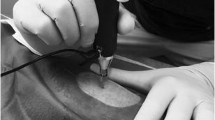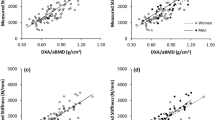Abstract
Summary
Using combined dual-energy X-ray absorptiometry (DXA) and quantitative computed tomography, we demonstrate that men matched with women for femoral neck (FN) areal bone mineral density (aBMD) have lower volumetric BMD (vBMD), higher bone cross-sectional area, and relatively similar values for finite element (FE)-derived bone strength.
Introduction
aBMD by DXA is widely used to identify patients at risk for osteoporotic fractures. aBMD is influenced by bone size (i.e., matched for vBMD, larger bones have higher aBMD), and increasing evidence indicates that absolute aBMD predicts a similar risk of fracture in men and women. Thus, we sought to define the relationships between FN aBMD (assessed by DXA) and vBMD, bone size, and FE-derived femoral strength obtained from quantitative computed tomography scans in men versus women.
Methods
We studied men and women aged 40 to 90 years and not on osteoporosis medications.
Results
In 114 men and 114 women matched for FN aBMD, FN total cross-sectional area was 38% higher (P < 0.0001) and vBMD was 16% lower (P < 0.0001) in the men. FE models constructed in a subset of 28 women and 28 men matched for FN aBMD showed relatively similar values for bone strength and the load-to-strength ratio in the two groups.
Conclusions
In this cohort of young and old men and women from Rochester, MN, USA who are matched by FN aBMD, because of the offsetting effects of bone size and vBMD, femoral strength and the load-to-strength ratio tended to be relatively similar across the sexes.




Similar content being viewed by others
References
Miller PD, Zapalowski C, Kulak CAM, Bilezikian JP (1999) Bone densitometry: the best way to detect osteoporosis and to monitor therapy. J Clin Endocrinol Metab 84:1867–1871
Orwoll E (2000) Perspective. Assessing bone density in men. J Bone Miner Res 15:1867–1870
Riggs BL, Melton LJ III, Robb RA, Camp JJ, Atkinson EJ, Peterson JM, Rouleau PA, McCollough CH, Bouxsein ML, Khosla S (2004) Population-based study of age and sex differences in bone volumetric density, size, geometry, and structure at different skeletal sites. J Bone Miner Res 19:1945–1954
Kanis JA, WHO Study Group (1994) Assessment of fracture risk and its application to screening for postmenopausal osteoporosis: synopsis of a WHO report. Osteoporos Int 4:368–381
Khosla S, Amin S, Orwoll E (2008) Osteoporosis in men. Endocr Rev 29:441–464
Kanis JA, Johnell O, Oden A, De Laet C, Mellstrom D (2001) Diagnosis of osteoporosis and fracture threshold in men. Calcif Tissue Int 69:218–221
De Laet CEDH, Van Hout BA, Burger H, Weel AEAM, Hofman A, Pols HAP (1998) Hip fracture prediction in elderly men and women: validation in the Rotterdam study. J Bone Miner Res 13:1587–1593
Melton LJ, Orwoll ES, Wasnich RD (2001) Does bone density predict fractures comparably in men and women? Osteoporos Int 12:707–709
Johnell O, Kanis JA, Oden A et al (2005) Predictive value of BMD for hip and other fractures. J Bone Miner Res 20:1185–1194
Kanis JA, Johnell O, Oden A, Johansson H, McCloskey E (2008) FRAX and the assessment of fracture probability in men and women from the UK. Osteoporos Int 19:385–397
Crawford RP, Cann CE, Keaveny TM (2003) Finite element models predict in vitro vertebral body compressive strength better than quantitative computed tomography. Bone 33:744–750
Keaveny TM, Hoffmann PF, Singh M, Palermo P, Bilezikian JP, Greenspan SL, Black DM (2008) Femoral bone strength and its relation to cortical and trabecular changes after treatment with PTH, alendronate, and their combination as assessed by finite element analysis of quantitative CT scans. J Bone Miner Res 23:1974–1982
Orwoll E, Marshall LM, Nielson CM et al (2009) Finite element analysis of the proximal femur and hip fracture risk in older men. J Bone Miner Res 24:475–483
Keyak JH (2001) Improved prediction of proximal femoral fracture load using nonlinear finite element models. Med Eng Phys 23:165–173
Cody DD, Gross GJ, Hou FJ, Spencer HJ, Goldstein SA, Fyhrie DP (1999) Femoral strength is better predicted by finite element models than QCT and DXA. J Biomech 32:1013–1020
Melton LJ III (1996) History of the Rochester Epidemiology Project. Mayo Clin Proc 71:266–274
Cann CE (1988) Quantitative CT for determination of bone mineral density: a review. Radiology 166:509–522
Kalender WA, Felsenberg D, Genant HK, Fischer M, Dequeker J, Reeve J (1995) The European spine phantom: a tool for standardization and quality control in spinal bone mineral measurements by DXA and QCT. Eur J Radiol 20:83–92
Camp JJ, Karwoski RA, Stacy MC, Atkinson EJ, Khosla S, Melton LJ, Riggs BL, Robb RA (2004) A system for the analysis of whole-bone strength from helical CT images. Proc SPIE 5369:74–88
Morgan EF, Keaveny TM (2001) Dependence of yield strain of human trabecular bone on anatomic site. J Biomech 34:569–577
Morgan EF, Bayraktar HH, Keaveny TM (2003) Trabecular bone modulus–density relationships depend on anatomic site. J Biomech 36:897–904
Bayraktar HH, Morgan EF, Niebur GL, Morris GE, Wong EK, Keaveny TM (2004) Comparison of the elastic and yield properties of human femoral trabecular and cortical bone tissue. J Biomech 37:27–35
Keaveny TM, Morgan EF, Niebur GL, Yeh OC (2001) Biomechanics of trabecular bone. Annu Rev Biomed Eng 3:307–333
Reilly DT, Burstein AH (1975) The elastic and ultimate properties of compact bone tissue. J Biomech 8:393–405
Roberts BJ, Kopperdahl DL, Thrall E, Muller J, Keaveny TM, Bouxsein ML (2009) Prediction of femoral strength in a sideways fall configuration using QCT-based finite element analysis. Bone 44:S72
Keaveny TM, Bouxsein ML (2008) Theoretical implications of the biomechanical fracture threshold. J Bone Miner Res 23:1541–1547
van den Kroonenberg AJ, Hayes WC, McMahon TA (1995) Dynamic models for sideways falls from standing height. J Biomech Eng 117:309–318
Robinovitch SN, McMahon AP, Hayes WC (1995) Force attenuation in trochanteric soft tissues during impact from a fall. J Orthop Res 13:956–962
Cummings SR, Cawthon PM, Ensrud KE, Cauley JA, Fink HA, Orwoll ES, Osteoporotic Fractures in Men (MrOS) Research Groups, Study of Osteoporotic Fractures Research Groups (2006) BMD and risk of hip and nonvertebral fractures in older men: a prospective study and comparison with older women. J Bone Miner Res 21:1550–1556
Keyak JH, Sigurdsson S, Karlsdottir G et al (2011) Male-female differences in the association between incident hip fracture and proximal femoral strength: a finite element analysis study. Bone 48:1239–1245
Riggs BL, Melton LJI, Robb RA, Camp JJ, Atkinson EJ, McDaniel L, Amin S, Rouleau PA, Khosla S (2008) A population-based assessment of rates of bone loss at multiple skeletal sites: evidence for substantial trabecular bone loss in young adult women and men. J Bone Miner Res 23:205–214
Acknowledgments
We would like to thank Sara Achenbach for her help with the statistical analyses, Jim Peterson for his help with data management, and Margaret Holets for the DXA aBMD measurements and analysis of the QCT scans.
Conflicts of interest
B.S., S.A., E.J.A., J.C., R.A.R., B.L.R., L.J.M., and S.K. have nothing to disclose. D.L.K. is an employee of O. N. Diagnostics and T.M.K. has a financial interest in O. N. Diagnostics and both they and the company may benefit from the results of this research.
Author information
Authors and Affiliations
Corresponding author
Additional information
This study was supported by NIH grants R01 AR027065, R43 AR052234, and 1UL1RR024150.
Rights and permissions
About this article
Cite this article
Srinivasan, B., Kopperdahl, D.L., Amin, S. et al. Relationship of femoral neck areal bone mineral density to volumetric bone mineral density, bone size, and femoral strength in men and women. Osteoporos Int 23, 155–162 (2012). https://doi.org/10.1007/s00198-011-1822-8
Received:
Accepted:
Published:
Issue Date:
DOI: https://doi.org/10.1007/s00198-011-1822-8




